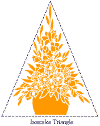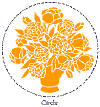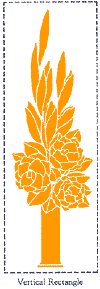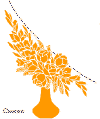| Arranging
Fresh flowers
Knowing
a few basic principles of flower arranging can help you add beauty
and life to your home. These tips will help you learn these
principles.
 Materials
Needed Materials
Needed
Flowers
from your own garden, or cut flowers from a florist
A container, usually
one of simple design
Tools or materials
to hold the flowers in place such as one or more of the following:
- A metal
pinpoint "frog," available at variety stores
- A block of
"oasis," available from florists
- Some pebbles
or sand
- Some crunched
up pfitzer juniper or other branches to be stuffed in the vase
Florist's clay to
hold frog in place (if you are using a metal frog)
Scissors or snippers
(some prefer a sharp knife to cut flowers on a slant)
 Preparation Preparation
To
help flowers last longer:
- Use clean
containers to slow bacterial growth.
- Use a sharp
knife or scissors to make a clean cut on the flower stem.
- Cut most
flowers the evening before using them and place them in a
bucket of warm water (too hot or too cold may shock the
flowers).
- Fill the
bucket of water up to within a few inches of the heads of the
flowers and put them in a cool place overnight.
- Roses are best
picked in mid-afternoon, when the sap is up in the stem.
- Dahlias and
poppies are often burned at the end of the stem, or recut
under water.
 Activity Activity
Remove
all dirt and old leaves from the flowers. Remove leaves that will
be under water. Place a frog firmly in the bottom of the container
with clay. You may use other items to hold the flowers in place
such as oasis, sand, or chicken wire.
Have a design in
mind when you start arranging. Geometric shapes are most commonly
used. Try a triangle, a half circle, an S shape, or a rectangle (see
illustration). Start by placing the longer stems with smaller
flower heads in the background.
Usually place the
larger flowers closer to the lip or edge of the container. Cut the
larger flower stems shorter. Cut each flower stem a different
length. The arrangement is more effective when the stems are at
all different levels.
Keep in mind that
simplicity is the key to a beautiful floral design. You don't need
a lot of flowers. Actually, each one will show better when the
arrangement is not overcrowded.
 Look
for gracefully bent branches and let them form the outer design.
Follow these lines with other flowers and filer branches, but
don't cover the original graceful line. Experiment with color
harmonies to see which colors blend well. Look
for gracefully bent branches and let them form the outer design.
Follow these lines with other flowers and filer branches, but
don't cover the original graceful line. Experiment with color
harmonies to see which colors blend well.
Keep the
following things in mind as you choose flowers for a vase: scale
of flowers to container (smaller flowers in smaller vase, large
flowers in larger vase); balance of flowers (see that the
arrangement is not too heavy on one side); harmony with the other
furniture or surroundings. When putting flowers on a dining table,
keep the flower arrangement rather low, usually below eye level,
so that it won't interfere with conversation.
Use the
illustrations to the right as guides for flower arranging.
|
